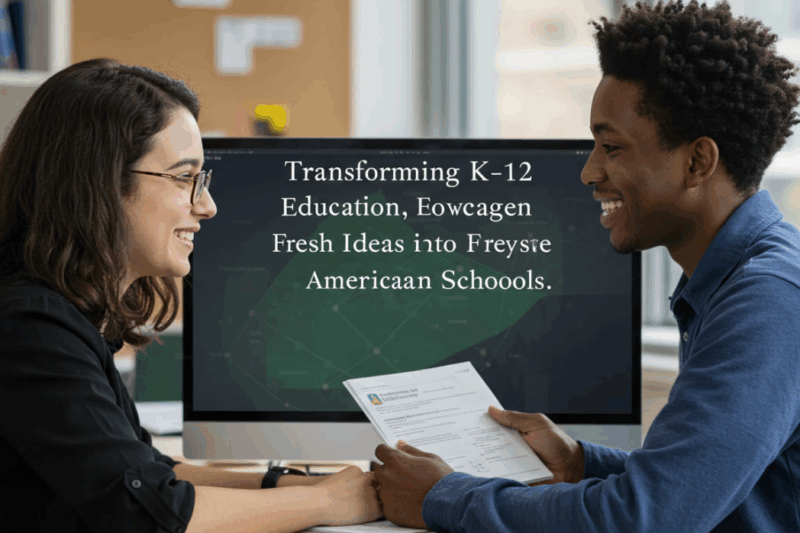The landscape of higher education in the USA is undergoing a profound transformation, driven by technological advancements, shifting societal needs, and evolving student expectations. As colleges and universities adapt to these changes, they are reimagining how education is delivered, accessed, and valued. From the integration of cutting-edge technology to a renewed focus on student success, the future of higher education promises to be dynamic and inclusive. In this article, we explore the key trends shaping US universities, highlight innovative approaches to academic excellence, and provide insights into what lies ahead for students, educators, and institutions.
The Rise of Online and Hybrid Learning Models
Embracing Digital Classrooms
The rapid adoption of online learning, accelerated by the global pandemic, has reshaped higher education. US universities are increasingly offering fully online degrees and hybrid programs that combine in-person and virtual instruction. Platforms like Coursera, edX, and university-specific portals have made it possible for students to access high-quality courses from anywhere, breaking down geographical barriers. This shift not only caters to non-traditional students, such as working professionals and parents, but also allows institutions to scale their offerings and reach a global audience.
Enhancing Flexibility and Accessibility
Hybrid learning models are gaining traction for their flexibility, blending the benefits of face-to-face interaction with the convenience of digital tools. For instance, universities like Arizona State University have pioneered scalable online programs that maintain rigorous academic standards. These models prioritize accessibility, enabling students to tailor their education to their schedules. As a result, higher education is becoming more inclusive, accommodating diverse learners who may have previously been excluded due to time or location constraints.

Artificial Intelligence and Personalized Education
AI-Powered Learning Experiences
Artificial intelligence (AI) is revolutionizing how students engage with academic content. AI-driven platforms, such as adaptive learning software, analyze student performance in real-time to deliver personalized learning paths. For example, tools like Smart Sparrow adjust coursework difficulty based on individual progress, ensuring that students remain challenged yet supported. This trend is particularly impactful in large introductory courses, where personalized feedback can enhance student success and retention rates.
Preparing Students for an AI-Driven Workforce
Beyond the classroom, AI is shaping curricula to prepare students for a tech-driven job market. US universities are integrating AI-related courses into non-technical disciplines, such as business, healthcare, and the humanities. Institutions like Stanford and MIT are leading the charge by offering interdisciplinary programs that combine AI with ethics and policy studies. This approach equips graduates with the skills to navigate an economy where automation and data-driven decision-making are increasingly prevalent.
The Shift Toward Competency-Based Education
Moving Beyond Traditional Degrees
Competency-based education (CBE) is gaining momentum as an alternative to traditional degree structures. CBE focuses on mastering specific skills rather than accumulating credit hours, allowing students to progress at their own pace. Universities like Western Governors University have embraced this model, enabling students to demonstrate proficiency through assessments rather than time-based coursework. This approach appeals to employers seeking candidates with practical, job-ready skills and to students looking for cost-effective, flexible education options.
Aligning Education with Industry Needs
CBE programs are designed in collaboration with industry leaders to ensure alignment with workforce demands. For example, partnerships between universities and companies like Google or Amazon have led to micro-credential programs in fields like cybersecurity and data analytics. These credentials, often stackable toward a degree, provide students with tangible qualifications that enhance employability. As the job market evolves, CBE is poised to play a critical role in bridging the gap between academia and industry.
Prioritizing Student Success and Well-Being
Holistic Support Systems
Student success is at the heart of modern higher education reforms. US universities are investing in comprehensive support systems that address academic, financial, and emotional needs. For instance, institutions like Georgia State University have implemented predictive analytics to identify at-risk students and provide targeted interventions, such as academic advising or financial aid counseling. These efforts have led to significant improvements in graduation rates, particularly for underrepresented groups.
Mental Health and Campus Culture
The mental health crisis among college students has prompted universities to prioritize well-being. Campuses are expanding counseling services, integrating mindfulness programs, and fostering inclusive environments. For example, the University of Michigan offers wellness coaching and peer support groups to help students manage stress. By creating a culture that values mental health, universities are not only enhancing student success but also preparing graduates to thrive in high-pressure professional settings.
The Role of Academic Innovation in Shaping the Future
Interdisciplinary and Experiential Learning
Academic innovation is driving the development of interdisciplinary programs that encourage creative problem-solving. Universities are moving away from rigid departmental structures, offering degrees that combine fields like environmental science and public policy or computer science and design. Experiential learning opportunities, such as internships, research projects, and study abroad programs, are also becoming integral to curricula, providing students with real-world experience that enhances their academic journey.
Lifelong Learning and Micro-Credentials
The concept of lifelong learning is gaining traction as professionals seek to upskill throughout their careers. US universities are responding by offering micro-credentials, such as digital badges and certificates, that validate specific skills. Platforms like LinkedIn Learning and university partnerships provide accessible pathways for continuous education. This trend reflects a broader shift toward viewing higher education as a lifelong process rather than a one-time experience.
Quotes from Thought Leaders in Higher Education
“The future of higher education lies in its ability to adapt to a rapidly changing world, embracing technology and inclusivity to empower every learner.” – Dr. Michael Crow, President of Arizona State University
“We must reimagine education as a flexible, lifelong journey that equips students for a dynamic global economy.” – Dr. Angel Cabrera, President of Georgia Institute of Technology
“Technology is not a replacement for human connection in education; it’s a tool to enhance it.” – Dr. Bridget Burns, Executive Director of the University Innovation Alliance
These insights from leading educators highlight the need for innovation, adaptability, and a student-centered approach in shaping the future of higher education. Their vision underscores the importance of balancing technological advancements with the human elements that define a meaningful educational experience.
The Impact of Demographic and Economic Shifts
Addressing Declining Enrollment
US universities are grappling with declining enrollment due to demographic changes, such as lower birth rates and a shrinking pool of college-aged students. To counter this, institutions are expanding outreach to non-traditional students, including adult learners and international students. For example, community colleges are partnering with four-year universities to create seamless transfer pathways, making higher education more accessible and affordable.
Affordability and Financial Innovation
The rising cost of tuition remains a significant barrier to higher education. In response, universities are exploring innovative financial models, such as income-share agreements (ISAs), where students pay a percentage of their income after graduation instead of upfront tuition. Purdue University’s “Back a Boiler” program is a notable example, offering a debt-free alternative for students. These models aim to reduce financial stress and align education costs with career outcomes.
Sustainability and Social Responsibility
Embedding Sustainability in Curricula
As global challenges like climate change intensify, universities are integrating sustainability into their academic offerings. Programs in renewable energy, sustainable agriculture, and environmental policy are preparing students to address pressing global issues. For instance, the University of California system has committed to carbon neutrality by 2025, influencing both campus operations and academic priorities.
Promoting Equity and Inclusion
Higher education is also prioritizing diversity, equity, and inclusion (DEI). Universities are implementing initiatives to recruit and retain underrepresented students, faculty, and staff. Scholarships, mentorship programs, and inclusive curricula are helping to create equitable academic environments. These efforts ensure that the future of higher education reflects the diverse society it serves.
FAQ
What are the biggest trends shaping higher education in the USA?
Key trends include the rise of online and hybrid learning, AI-driven personalization, competency-based education, and a focus on student well-being. These changes aim to make education more accessible, flexible, and aligned with workforce needs.
How is technology impacting US universities?
Technology is transforming higher education through online platforms, AI-powered learning tools, and data analytics for student support. It enhances accessibility, personalizes education, and prepares students for tech-driven careers.
What is competency-based education, and why is it important?
Competency-based education (CBE) focuses on mastering skills rather than accumulating credit hours. It’s important because it aligns education with industry needs, offers flexibility, and provides cost-effective pathways to credentials.
How are universities addressing student mental health?
Universities are expanding counseling services, offering wellness programs, and fostering inclusive campus cultures to support student mental health. These efforts aim to improve retention and overall student success.
How can higher education become more affordable?
Innovative financial models, such as income-share agreements and micro-credentials, are making education more affordable. Partnerships with community colleges and online programs also reduce costs for students.



